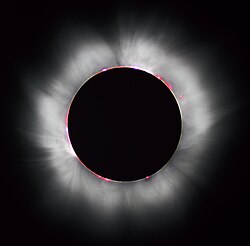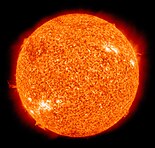恆星大氣層:修订间差异
删除的内容 添加的内容
Yinweichen-bot(留言 | 贡献) 小 機械人根據格式手冊移除多餘日期內鏈 |
无编辑摘要 |
||
| 第2行: | 第2行: | ||
'''恆星大氣層'''是[[恆星]]的最外層區域,位置在[[太陽核心|核心]]、[[太陽#輻射層|輻射層]]和[[太陽#對流層|對流層]]之上,依照獨特的特徵可以分為數層: |
'''恆星大氣層'''是[[恆星]]的最外層區域,位置在[[太陽核心|核心]]、[[太陽#輻射層|輻射層]]和[[太陽#對流層|對流層]]之上,依照獨特的特徵可以分為數層: |
||
[[光球層]]是大氣層的最底層,也是我們能觀察到的大氣層中溫度最低的一層。來自恆星的[[光]]經由這一層從穿越更高的數層後,由恆星的表面逃逸入太空。[[太陽]]的光球層溫度為5700[[絕對溫度|K]],[[星斑]]是光球層上受到[[磁場]]擾亂而溫度較低的區域。 |
* [[光球層]]是大氣層的最底層,也是我們能觀察到的大氣層中溫度最低的一層<ref name = "BrightPS"/>。來自恆星的[[光]]經由這一層從穿越更高的數層後,由恆星的表面逃逸入太空。[[太陽]]的光球層溫度為5700[[絕對溫度|K]]到5,780 K范围<ref name = "lowTemp">{{Cite book|last1= Mariska |first1= J.T. |title= The solar transition region |series = Cambridge Astrophysics Series |url = http://www.cambridge.org/catalogue/catalogue.asp?isbn=9780521382618&ss=toc |publisher= Cambridge University Press |isbn= 978-0-521-38261-8 }}</ref><ref name = "higherTemp"/>,[[星斑]]是光球層上受到[[磁場]]擾亂而溫度較低的區域<ref name = "higherTemp">{{Cite book|last1= Lang |first1= K.R. |title= Sun, earth, and sky |edition= 2nd |date=September 2006 |publisher= Springer |isbn= 978-0-387-30456-4 |page= 81 |chapter= 5.1 MAGNETIC FIELDS IN THE VISIBLE PHOTOSPHERE |quote= this opaque layer is the photosphere, the level of the Sun from which we get our light and heat }}</ref>。 |
||
在光球層之上的是[[色球層]],這一層開始時的溫度會下降,然後隨著高度上升逐漸增溫至光球層的10倍左右。 |
* 在光球層之上的是[[色球層]],這一層開始時的溫度會下降,然後隨著高度上升逐漸增溫至光球層的10倍左右。 |
||
* 在色球層之上還有[[過渡區]],在這裡溫度在約100公里的距離內迅速的增加至百萬K<ref>{{Cite book|last1= Mariska |first1= J.T. |title= The solar transition region |isbn= 978-0-521-38261-8 |page = 60 |quote = 100 km suggested by average models }}</ref>。 |
|||
| ⚫ | |||
| ⚫ | * 在這之上就是恆星大氣層的外圍部份,是由非常稀薄但極端高溫(百萬K)的[[等離子體|電漿]]構成的[[冕 (大氣層)|星冕]]<ref>{{Cite journal|author= R.C. Altrock |date= 2004 |title= The Temperature of the Low Corona During Solar Cycles 21–23 |journal= Solar Physics |volume= 224 |page = 255 |doi= 10.1007/s11207-005-6502-4 |bibcode = 2004SoPh..224..255A }}</ref>,[[過渡區]]和[[冕 (大氣層)|星冕]]是在[[主序星|主序帶]]上所有的[[恆星]]都有的外觀。但不是所有演化中的恆星都是如此,看起來只有一些[[巨星]]和極少數的[[超巨星]]才有[[冕 (大氣層)|星冕]]。在[[天體物理學]]中尚待待解決的問題是星冕是如何被加熱到如此高的溫度?答案可能在恆星的[[磁場]]上,但確切的機制依然還沒有被清楚了解<ref>{{Cite web|url= http://imagine.gsfc.nasa.gov/docs/science/mysteries_l1/corona.html |title= The Sun's Corona – Introduction |publisher= [[NASA]] |accessdate= 2010-05-21 | quote = Now most scientists believe that the heating of the corona is linked to the interaction of the magnetic field lines.}}</ref>。 |
||
| ⚫ | |||
| ⚫ | |||
| ⚫ | |||
{{Cite web|url= http://www.sciencedaily.com/releases/1999/08/990805111308.htm |title= "Beyond the Blue Horizon" – A Total Solar Eclipse Chase | date=1999-08-05 |accessdate= 2010-05-21 | quote = On ordinary days, the corona is hidden by the blue sky, since it is about a million times fainter than the layer of the sun we see shining every day, the photosphere.}}</ref>。在這種情況下,色球層呈現出略帶粉紅色的圓弧<ref> |
|||
{{Cite book|last1= Lewis |first1= J.S. |title= Physics and chemistry of the solar system | publisher = Elsevier Academic Press |edition= Second |date= 2004-02-23 |isbn= 978-0-12-446744-6 | quote = The dominant color is influenced by the [[Balmer series|Balmer radiation]] of atomic hydrogen |page= 87 }} |
|||
</ref>,而[[日冕]](太陽的星冕)像裝了一簇纓球的光暈。 |
|||
== 参阅 == |
|||
| ⚫ | |||
* [[塞西莉亞·佩恩-加波施金]]- 首先提出了当前接受的恒星大氣層组成的天文学家。 |
|||
== 参考资料== |
|||
{{reflist}} |
|||
{{太陽}} |
|||
| ⚫ | |||
| ⚫ | |||
2017年6月18日 (日) 17:35的版本

恆星大氣層是恆星的最外層區域,位置在核心、輻射層和對流層之上,依照獨特的特徵可以分為數層:
- 光球層是大氣層的最底層,也是我們能觀察到的大氣層中溫度最低的一層[1]。來自恆星的光經由這一層從穿越更高的數層後,由恆星的表面逃逸入太空。太陽的光球層溫度為5700K到5,780 K范围[2][3],星斑是光球層上受到磁場擾亂而溫度較低的區域[3]。
- 在光球層之上的是色球層,這一層開始時的溫度會下降,然後隨著高度上升逐漸增溫至光球層的10倍左右。
- 在這之上就是恆星大氣層的外圍部份,是由非常稀薄但極端高溫(百萬K)的電漿構成的星冕[5],過渡區和星冕是在主序帶上所有的恆星都有的外觀。但不是所有演化中的恆星都是如此,看起來只有一些巨星和極少數的超巨星才有星冕。在天體物理學中尚待待解決的問題是星冕是如何被加熱到如此高的溫度?答案可能在恆星的磁場上,但確切的機制依然還沒有被清楚了解[6]。
以太陽為例,當日全食之際,太陽的光球層被遮蔽時,大氣層中的其他層次便被顯露出來[1]。在這種情況下,色球層呈現出略帶粉紅色的圓弧[7],而日冕(太陽的星冕)像裝了一簇纓球的光暈。
参阅
- 塞西莉亞·佩恩-加波施金- 首先提出了当前接受的恒星大氣層组成的天文学家。
参考资料
- ^ 1.0 1.1
"Beyond the Blue Horizon" – A Total Solar Eclipse Chase. 1999-08-05 [2010-05-21].
On ordinary days, the corona is hidden by the blue sky, since it is about a million times fainter than the layer of the sun we see shining every day, the photosphere.
- ^ Mariska, J.T. The solar transition region. Cambridge Astrophysics Series. Cambridge University Press. ISBN 978-0-521-38261-8.
- ^ 3.0 3.1 Lang, K.R. 5.1 MAGNETIC FIELDS IN THE VISIBLE PHOTOSPHERE. Sun, earth, and sky 2nd. Springer. September 2006: 81. ISBN 978-0-387-30456-4.
this opaque layer is the photosphere, the level of the Sun from which we get our light and heat
- ^ Mariska, J.T. The solar transition region. : 60. ISBN 978-0-521-38261-8.
100 km suggested by average models
- ^ R.C. Altrock. The Temperature of the Low Corona During Solar Cycles 21–23. Solar Physics. 2004, 224: 255. Bibcode:2004SoPh..224..255A. doi:10.1007/s11207-005-6502-4.
- ^ The Sun's Corona – Introduction. NASA. [2010-05-21].
Now most scientists believe that the heating of the corona is linked to the interaction of the magnetic field lines.
- ^
Lewis, J.S. Physics and chemistry of the solar system Second. Elsevier Academic Press. 2004-02-23: 87. ISBN 978-0-12-446744-6.
The dominant color is influenced by the Balmer radiation of atomic hydrogen
| |||||||||||||||||||||||||||||||||||||||||||||||
| ||||||||||||||||||||||||||||||||||


